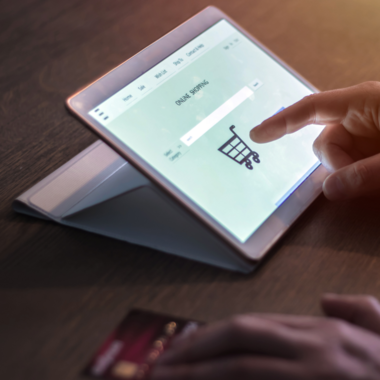
- Five minutes read
Key takeaways from Lost in Transaction: The end of risk?
Our latest research report examines consumer appetite for biometrics to replace passwords in CNP payment authentication, and how voice-activated payments will have an impact on eCommerce
The growth of mCommerce is already driving biometric authentication
48% of consumers have already authenticated a payment using some form of biometric authentication, rising to 54% in the UK. There is strong evidence to support the theory that this adoption is being driven by the growth of mobile commerce, and particularly by consumers under the age of 40.
The correlation between mCommerce and biometric identification is marked, with 18-24-year-olds (75% adoption of mCommerce; 69% adoption of biometrics) and 25-39-year-olds (79% adoption of mCommerce; 61% adoption of biometrics) being the greatest adopters in both areas.
Consumers think biometric authentication is more convenient, but are still unwilling to move away from passwords
When asked which authentication factor they felt most comfortable using, passwords were the most popular choice of consumers, ahead of biometrics and SMS code authentication. This choice was based on concerns about security, rather than convenience.
61% of consumers believe that using biometrics is a much quicker and more efficient way of paying for goods or services than traditional online payment methods, and 57% of consumers agree that being able to verify their payments using biometric technology will make shopping on their smartphone more convenient than traditional desktop eCommerce.
However, consumers are less aware of the security benefits of biometric authentication. Only 37% of consumers believe that biometrics are more secure than other verification methods and 66% of consumers said they would be worried if they were able to make purchases without being prompted for a password.
Consumers have strong concerns about the security of their financial data, which is preventing adoption
53% of consumers believe that voice-activated payments are quicker and more convenient than traditional online payment methods, but only 37% feel comfortable that their financial details remained secure when making a payment via a Smart Home device.
Traditionally consumers in Germany and Austria are less prepared to accept risk when making payments online, and this is reflected in their willingness to make payments using voice-activated technology. Only 36% of German and Austrian consumers said they would use a Smart Home device to buy goods or service, whereas 50% of Bulgarian consumers said that they were comfortable making payments this way.
Consumers are more comfortable re-ordering low value items and buying entertainment services than making high value or one-off purchases
There is a clear distinction between consumer appetite for ordering and shopping. More consumers are prepared to order lunch (35%) or groceries (31%) from merchants that they shop with regularly, but fewer are prepared to make one-off purchases from stores they are less familiar with such as Christmas and birthday gifts (22%) or furniture (17%).
Consumers are also less willing to make high value purchases using voice-activated technology. Only 18% of consumers are currently prepared to book a holiday or pay for a flight using a Smart Home device.
33% of consumers will not consider using voice-activated technology for any type of payment.
Generation Z is more willing to use voice-activated technology to make payments than any other age demographic
When it comes to both Smart Home and Internet of Things enabled purchases, 18-24-year-olds appear much more willing to embrace voice-activated technology than older generations. More than half of consumers in this age bracket would sign up for a subscription service such as Netflix (52%) or make a one-off entertainment purchase (51%) using voice-activated technology, and 43% would be prepared to pay for groceries using voice command to their Smart Fridge. 39% of 18-24-year-olds would make payments using their voice through their car’s entertainment system.
Lost in Transaction: The end of risk? is available to download now.




